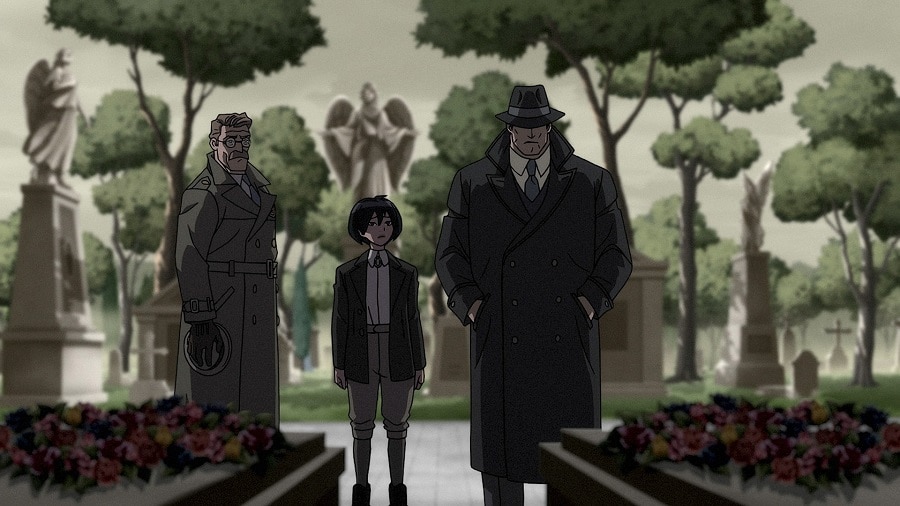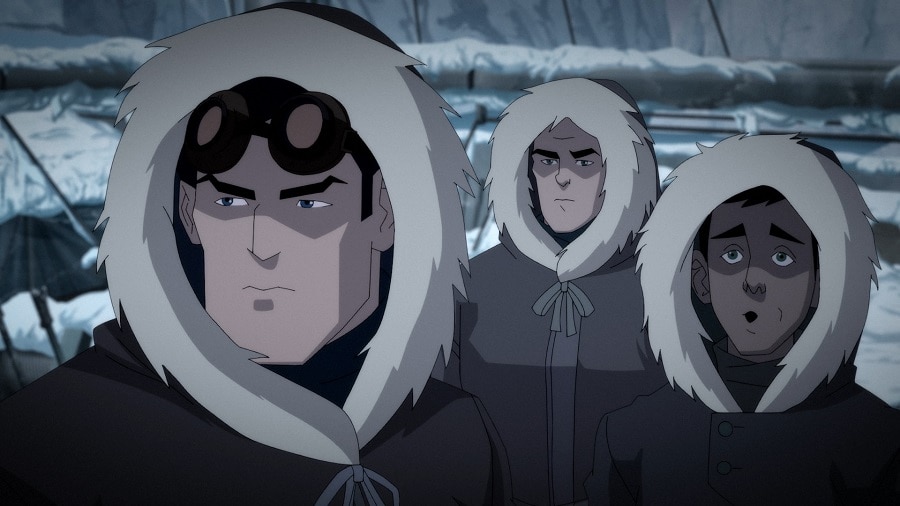Gotham City is a busy place, with a lot going down each and every week. In this monthly column, Joshua Lapin-Bertone helps you stay on top of it all by letting you know what you should be paying attention to within the Bat-Family…and why.
What happens when you combine Lovecraftian monsters, demonic rituals, rotten fathers and Batman? You get Batman: The Doom That Came to Gotham, the latest DC Universe animated film. Based on the critically acclaimed Elseworlds limited series, this story reimagines Batman as an explorer who fights monsters in the 1920s. Like most alternate continuity tales, some familiar faces show up, but each character has their own unique spin.
Think of this film as “what if Batman had been written by H.P. Lovecraft?” But before I go any further, I need to warn everyone that there are spoilers ahead. The film is currently available as a digital download and on Blu-ray, so I would suggest checking it out before you read any further. There are some very big surprises in this film, which we need to address—especially that ending!

One of the great things about Batman Elseworlds stories is that they can break all the rules. In a regular continuity tale, most of the pieces have to be put back together again when the story is done. While occasionally there are status quo changes in the main continuity, for the most part Batman and his core characters remain intact. In Elseworlds tales, though, nobody is safe and these characters can have endings. But remember, not all endings mean death.
For example, Batman: The Doom That Came to Gotham ends with Bruce being transformed, but far more literally than you might be used to. In order to defeat Ra’s al Ghul, who had become a Cthulhu-like monstrosity (I told you this movie was insane), Bruce allows himself to die and be reborn as a monstrous bat. I could type something here about how this alludes to the fact that Bruce has always embraced his Batman side more than his human side, but that could be overthinking it. It’s a moment of horror, and it’s also really cool.
It’s interesting to note what Batman does next, however. When the film ends, we see Batman hiding in a clocktower, watching over Gotham like some sort of silent guardian. It’s a moment that proves that while some things may change when it comes to the Dark Knight, others never will. Bruce Wayne may have changed into a giant bat-monster, but he’s not going to hide in some jungle cave eating berries. He’s staying in Gotham to protect it. Even when he’s lost every part of his humanity, protecting Gotham is his most primal urge.

As much as this Elseworlds film shakes up the status quo, it also reminds us that Batman’s core remains consistent no matter what continuity he’s in. Yes, there have been times where he has walked away from Gotham, but at his heart, he’s a driven hero of the shadows who will never stop thinking of ways to protect his city. That’s the tricky tightrope walk that alternate universe stories must do. They can make everything different, but the characters still need to be true to their core. Batman’s ending accomplished both.
It's also interesting to see how the setting changes Batman and his allies. Batman was created in 1939, yet he remains a timeless character who could work in any era. However, it’s worth exploring what Bruce would have been like if he had been active in the 1920s. For starters, it means less bat-gadgets, since the world was slightly less advanced.
Interestingly, this version of Bruce was an explorer before settling back into Gotham. He traveled around the world, exploring strange occurrences…and collecting orphans at various ports. (Like I said, the core doesn’t change.) As a result, we get to meet some different versions of familiar sidekicks. There is Dick Grayson, Sanjay Tawde (say it aloud), and Kai Lai Cain. Their dynamic is fun, but this is an Elseworlds story and a super dark one at that, so not everyone gets out alive.

Amusingly, Sanjay’s death happens because he loses a straw poll. This could almost be seen as an homage to Jason Todd dying because he lost a telephone poll. I’m not sure I’d call Jason’s death one of his core qualities as a character, but it appears that in the multiverse, some things never change.
Batman: The Doom That Came to Gotham takes the Dark Knight out of his comfort zone, rocking him to his core. He’s faced with an enemy that he can barely comprehend, forcing him to question his entire worldview. The film is daring, full of surprises and new takes on the Bat-mythos. But it’s also a testament to who Batman is at his core and how some things are constant. Monsters will always lurk in Gotham, but there will always be a Batman watching over the city. Even if he’s a monster himself.
Batman: The Doom That Came to Gotham is now available on 4K Ultra HD Blu-ray Combo Pack, Blu-ray and Digital.
Joshua Lapin-Bertone writes about TV, movies and comics for DC.com, is a regular contributor to the Couch Club and writes our monthly Batman column, "Gotham Gazette." Follow him on Twitter at @TBUJosh.
NOTE: The views and opinions expressed in this feature are solely those of Joshua Lapin-Bertone and do not necessarily reflect those of DC Entertainment or Warner Bros., nor should they be read as confirmation or denial of future DC plans.




















